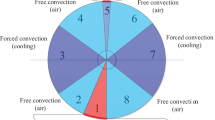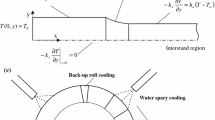Abstract
To quantify the effect of roll chilling on the thermal history of a slab during hot rolling, tests were conducted at the Canada Center for Mineral and Energy Technology (CANMET) and at the University of British Columbia (UBC). In these tests, the surface and the interior temperatures of specimens were recorded during rolling using a data acquisition system. The corresponding heat-transfer coefficients in the roll bite were back-calculated by a trial-and-error method using a heat-transfer model. The heat-transfer coefficient was found to increase along the arc of contact and reach a maximum, followed by a decrease, until the exit of the roll bite. Its value was influenced by rolling parameters, such as percent reduction, rolling speed, rolling temperature, material type,etc. It was shown that the heat-transfer coefficient in the roll gap was strongly dependent on the roll pressure, and the effect of different variables on the interfacial heat-transfer coefficient can be related to their influence on pressure. At low mean roll pressure, such as in the case of rolling plain carbon steels at elevated temperature, the maximum heat-transfer coefficient in the roll bite was in the 25 to 35 kW/m2 °C range. As the roll pressure increased with lower rolling temperature and higher deformation resistance of stainless steel and microalloyed grades, the maximum heat-transfer coefficient reached a value of 620 kW/m2 °C. Obviously, the high pressure improved the contact between the roll and the slab surface, thereby reducing the resistance to heat flow. The mean roll-gap heat-transfer coefficient at the interface was shown to be linearly related to mean roll pressure. This finding is important because it permitted a determination of heat-transfer coefficients applicable to industrial rolling from pilot mill data. Thus, the thermal history of a slab during rough rolling was computed using a model in which the mean heat-transfer coefficient between the roll and the slab was determined from an estimate of the rolling load. It was found that the heat loss of a slab to the roll was 33 pet of the total, which emphasizes the importance of accurately characterizing the heat-transfer coefficient in the roll bite during hot rolling.
Similar content being viewed by others
References
M.P. Pietrzyk and J.G. Lenard:J. Mater. Shap. Technol., 1989, vol. 7, pp. 117–26.
F. Hollander:Mathematical Models in Metallurgical Process Development, The Iron and Steel Institute, London, 1970, pp. 46–78.
I.V. Samarasekera:Proc. Int. Symp. on the Mathematical Modelling of the Hot Rolling of Steel, 29th Annual Conference of Metallurgists, CIMM, Hamilton, ON, Canada, 1990, Pergamon Press, New York, NY, pp. 145–67.
F. Seredynski:J. Iron Steel Inst., 1973, vol. 211, pp. 197–203.
Jun-ichi Kokado and N. Hatta:J. Jpn. Soc. Technol. Plast., 1978, vol. 19, p. 213.
A.A. Tseng, F.H. Lin, A.S. Gunderia, and D.S. Ni:Metall. Trans. A, 1989, vol. 20A, pp. 2305–320.
Ken-ichi Yanagi:Trans. Iron Steel Inst. Jpn. 1976, vol. 16, pp. 11–19.
P.G. Stevens, K.P. Ivens, and P. Harper:J. Iron Steel Inst., 1971, Jan., pp. 1–11.
A.J. Fletch, A.G. Gibson, and J.A. Gonzales:Met. Technol., 1984, pp. 156–66.
CM. Sellars:Mater. Sci. Technol., 1985, vol. 1, pp. 325–32.
C. Devadas, I.V. Samarasekera, and E.B. Hawbolt:Metall. Trans. B., 1991, vol. 22A, pp. 307–19.
H. Fenech, J.J. Henry, and W.M. Rohsenow: inDevelopments in Heat Transfer, W.M. Rohsenow, ed., MIT Press, Cambridge, MA, 1964, pp. 354–70.
T. Wanheim and N. Bay:Ann. CIRP, 1976, vol. 27 (1), pp. 189–93.
M. Pietrzyk and J.G. Lenard:Thermal-Mechanical Modelling of the Flat Rolling Process, Material Research and Engineering, Springer-Verlag, Berlin, Heidelberg, 1991.
S. Kobayash, S.I. Oh, and T. Altan:Metal Forming and Finite Element Method, Oxford Series on Manufacturing, Oxford University Press, New York, NY, 1989, pp. 138–39.
W.R.D. Wilson and S. Sheu:Int. J. Mech. Sci., 1988, vol. 30 (7), pp. 475–90.
W.R.D. Wilson:ASME Winter Annual Meeting, Dec. 1988, Chicago, IL.
An OMEGA Group Company:OMEGA Complete Temperature Measurement Handbook and Encyclopedia, OMEGA Engineering, Inc., vol. 26, T-12, Stanford, CT, 1988.
W.L. Robert:Hot Rolling of Steel, Manufacturing Engineering and Materials Processing, Marcel Dekker, Inc., New York, NY, 1983.
W.C. Chen, I.V. Samarasekera, and E.B. Hawbolt:lronmaking and Steelmaking, 1993, vol. 20 (1), pp. 1–13.
B.G. Thomas, I.V. Samarasekera, and J.K. Brimacombe:Metall. Trans. B, 1984, vol. 15B, pp. 307–18.
A. Kumar, I.V. Samarasekera, and E.B. Hawbolt:J. Mater. Process. Technol., 1992, vol. 30, pp. 91–114.
R.B. Sims:Proc. Inst. Mech. Eng., 1954, vol. 168, pp. 191–200.
Author information
Authors and Affiliations
Rights and permissions
About this article
Cite this article
Chen, W.C., Samarasekera, I.V. & Hawbolt, E.B. Fundamental phenomena governing heat transfer during rolling. Metall Trans A 24, 1307–1320 (1993). https://doi.org/10.1007/BF02668199
Received:
Published:
Issue Date:
DOI: https://doi.org/10.1007/BF02668199




